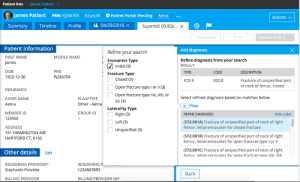Electronic Medical Record (EMR) Software integrated with robust Practice Management (PM) Software transforms the way healthcare professionals manage patient data. Practice management streamlines workflows, and improves the overall efficiency of medical practices. In this blog post, we will delve into the myriad ways in which EMR software tools can elevate practice management.
Centralized Patient Data Management
One of the primary advantages of implementing EMR software is the ability to centralize patient data. Traditional paper-based record-keeping systems are prone to errors, time-consuming, and often result in fragmented information. EMR software, on the other hand, allows healthcare providers to consolidate patient data into a secure, easily accessible digital format. From medical histories and lab results to treatment plans and medication records, all relevant information is stored in a centralized location. This enables healthcare professionals to make informed decisions quickly and efficiently.
Improved Workflow Efficiency Through Practice Management
EMR software tools streamline various administrative and clinical processes, significantly improving overall workflow efficiency. With features such as automated appointment scheduling, electronic prescription management, and real-time access to patient records, practitioners save valuable time. This also reduces the risk of errors associated with manual data entry. These tools also facilitate seamless communication between different departments within a medical practice. It helps foster collaboration and ensures that all team members are on the same page.
Practice Management Improves Patient Engagement
Effective patient engagement is crucial for the success of any medical practice. EMR software tools empower patients by providing them with secure access to their health records, appointment schedules, and test results. Through patient portals, patients actively participate in their healthcare journey, fostering a sense of transparency and trust. Features like secure messaging and online appointment scheduling further enhance communication and engagement, contributing to improved patient satisfaction.
Streamlined Billing and Revenue Cycle Management
Billing and revenue cycle management are often complex and time-consuming aspects of healthcare administration. EMR software tools offer integrated solutions that streamline billing processes, reducing the likelihood of errors and speeding up reimbursement cycles. Automated coding, claims submission, and electronic remittance advice (ERA) functionalities contribute to more accurate and efficient financial operations. This not only improves the financial health of the practice but also allows healthcare providers to focus more on patient care.
Regulatory Compliance and Data Security
In an era where data breaches and cybersecurity threats are prevalent, ensuring the security and privacy of patient information is paramount. EMR software tools are designed to adhere to stringent regulatory standards, such as the Health Insurance Portability and Accountability Act (HIPAA). These tools employ robust security measures, including encryption, access controls, and regular audits, to safeguard sensitive patient data. Compliance with these regulations not only protects patients but also shields healthcare providers from legal and financial repercussions associated with data breaches.
Data Analytics for Informed Decision-Making
EMR software tools provide valuable insights through data analytics, enabling healthcare providers to make informed decisions that can positively impact patient outcomes and practice efficiency. By analyzing trends in patient data, practitioners can identify areas for improvement, optimize resource allocation, and implement preventive measures. Data-driven decision-making is instrumental in enhancing the overall quality of care provided by medical practices.
Practice Management Enusres Seamless Integration of Healthcare Systems
Interoperability is a key feature of modern EMR software tools, allowing them to seamlessly integrate with other healthcare systems, such as laboratory information systems, pharmacy systems, and radiology systems. This integration facilitates the exchange of critical information between different healthcare providers and ensures that all relevant data is accessible from a single interface. This interoperability not only improves collaboration among healthcare professionals but also enhances the continuity of care for patients.









